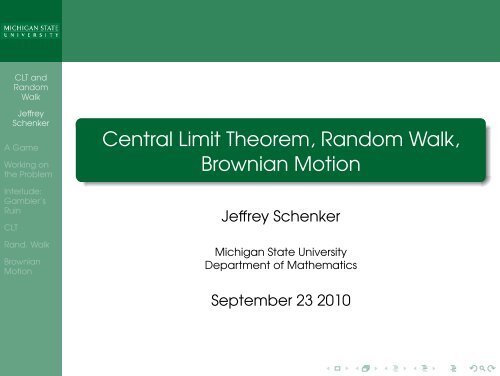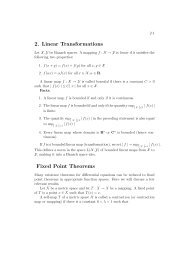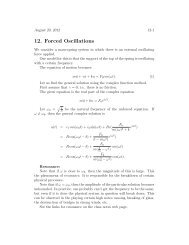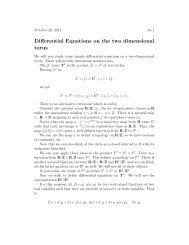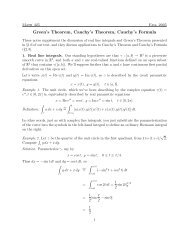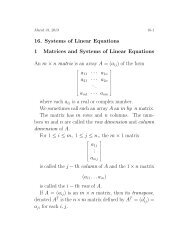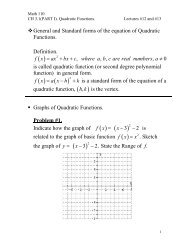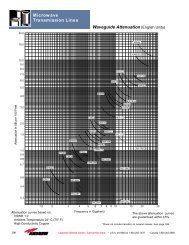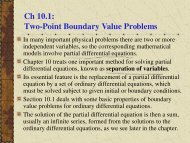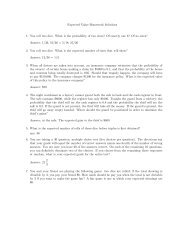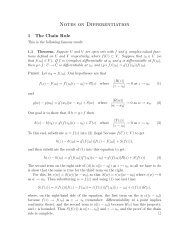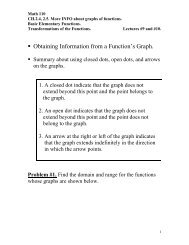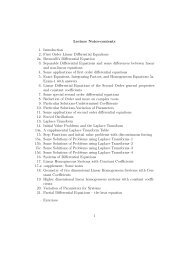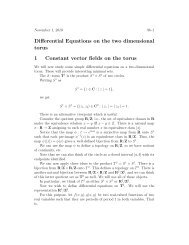Central Limit Theorem, Random Walk, Brownian Motion
Central Limit Theorem, Random Walk, Brownian Motion
Central Limit Theorem, Random Walk, Brownian Motion
- No tags were found...
Create successful ePaper yourself
Turn your PDF publications into a flip-book with our unique Google optimized e-Paper software.
OutlineCLT and<strong>Random</strong><strong>Walk</strong>JeffreySchenkerA GameWorking onthe ProblemInterlude:Gambler’sRuinCLTRand. <strong>Walk</strong><strong>Brownian</strong><strong>Motion</strong>1 Prelude: A Simple Game2 Working on the Problem3 Interlude: Gambler’s Ruin4 <strong>Central</strong> <strong>Limit</strong> <strong>Theorem</strong>5 <strong>Random</strong> <strong>Walk</strong>6 <strong>Brownian</strong> <strong>Motion</strong>
OutlineCLT and<strong>Random</strong><strong>Walk</strong>JeffreySchenkerA GameWorking onthe ProblemInterlude:Gambler’sRuinCLTRand. <strong>Walk</strong><strong>Brownian</strong><strong>Motion</strong>1 Prelude: A Simple Game2 Working on the Problem3 Interlude: Gambler’s Ruin4 <strong>Central</strong> <strong>Limit</strong> <strong>Theorem</strong>5 <strong>Random</strong> <strong>Walk</strong>6 <strong>Brownian</strong> <strong>Motion</strong>
A fair game.CLT and<strong>Random</strong><strong>Walk</strong>JeffreySchenkerA GameWorking onthe ProblemInterlude:Gambler’sRuinCLTRand. <strong>Walk</strong><strong>Brownian</strong><strong>Motion</strong>Flip a coinTails you win $1Heads I win $1Average winnings = 1 2 × $1 + 1 2× (−$1) = $0.
A fair game.CLT and<strong>Random</strong><strong>Walk</strong>JeffreySchenkerA GameWorking onthe ProblemInterlude:Gambler’sRuinCLTRand. <strong>Walk</strong><strong>Brownian</strong><strong>Motion</strong>Flip a coinTails you win $1Heads I win $1Average winnings = 1 2 × $1 + 1 2× (−$1) = $0.
A fair game.CLT and<strong>Random</strong><strong>Walk</strong>JeffreySchenkerA GameWorking onthe ProblemInterlude:Gambler’sRuinCLTRand. <strong>Walk</strong><strong>Brownian</strong><strong>Motion</strong>Flip a coinTails you win $1Heads I win $1Average winnings = 1 2 × $1 + 1 2× (−$1) = $0.
A fair game.CLT and<strong>Random</strong><strong>Walk</strong>JeffreySchenkerA GameWorking onthe ProblemInterlude:Gambler’sRuinCLTRand. <strong>Walk</strong><strong>Brownian</strong><strong>Motion</strong>Flip a coinTails you win $1Heads I win $1Average winnings = 1 2 × $1 + 1 2× (−$1) = $0.
How long can we play?CLT and<strong>Random</strong><strong>Walk</strong>JeffreySchenkerA GameWorking onthe ProblemInterlude:Gambler’sRuinCLTRand. <strong>Walk</strong><strong>Brownian</strong><strong>Motion</strong>Suppose we each start with $10.Sooner or later one of us runs outof money. How long does it take?It takes a random amount oftime.But.... we can say somethingabout it nonetheless.
How long can we play?CLT and<strong>Random</strong><strong>Walk</strong>JeffreySchenkerA GameWorking onthe ProblemInterlude:Gambler’sRuinCLTRand. <strong>Walk</strong><strong>Brownian</strong><strong>Motion</strong>Suppose we each start with $10.Sooner or later one of us runs outof money. How long does it take?It takes a random amount oftime.But.... we can say somethingabout it nonetheless.
How long can we play?CLT and<strong>Random</strong><strong>Walk</strong>JeffreySchenkerA GameWorking onthe ProblemInterlude:Gambler’sRuinCLTRand. <strong>Walk</strong><strong>Brownian</strong><strong>Motion</strong>Suppose we each start with $10.Sooner or later one of us runs outof money. How long does it take?It takes a random amount oftime.But.... we can say somethingabout it nonetheless.
Let’s Play!CLT and<strong>Random</strong><strong>Walk</strong>JeffreySchenkerA GameWorking onthe ProblemInterlude:Gambler’sRuinCLTRand. <strong>Walk</strong><strong>Brownian</strong><strong>Motion</strong>✞✝Click here☎✆
OutlineCLT and<strong>Random</strong><strong>Walk</strong>JeffreySchenkerA GameWorking onthe ProblemInterlude:Gambler’sRuinCLTRand. <strong>Walk</strong><strong>Brownian</strong><strong>Motion</strong>1 Prelude: A Simple Game2 Working on the Problem3 Interlude: Gambler’s Ruin4 <strong>Central</strong> <strong>Limit</strong> <strong>Theorem</strong>5 <strong>Random</strong> <strong>Walk</strong>6 <strong>Brownian</strong> <strong>Motion</strong>
Setting up the problem.CLT and<strong>Random</strong><strong>Walk</strong>JeffreySchenkerA GameWorking onthe ProblemInterlude:Gambler’sRuinCLTRand. <strong>Walk</strong><strong>Brownian</strong><strong>Motion</strong>Let w i = your winnings in i th round of the game.w i is a random variable:{$1 if the i th coin flip is tails,w i =−$1 if the i th coin flip is heads.w i and w j for different coin tosses areindependent.Your winnings after playing the game n times:W n = w 1 + w 2 + · · · + w n =n∑ w j .j=1
Setting up the problem.CLT and<strong>Random</strong><strong>Walk</strong>JeffreySchenkerA GameWorking onthe ProblemInterlude:Gambler’sRuinCLTRand. <strong>Walk</strong><strong>Brownian</strong><strong>Motion</strong>Let w i = your winnings in i th round of the game.w i is a random variable:{$1 if the i th coin flip is tails,w i =−$1 if the i th coin flip is heads.w i and w j for different coin tosses areindependent.Your winnings after playing the game n times:W n = w 1 + w 2 + · · · + w n =n∑ w j .j=1
Setting up the problem.CLT and<strong>Random</strong><strong>Walk</strong>JeffreySchenkerA GameWorking onthe ProblemInterlude:Gambler’sRuinCLTRand. <strong>Walk</strong><strong>Brownian</strong><strong>Motion</strong>Let w i = your winnings in i th round of the game.w i is a random variable:{$1 if the i th coin flip is tails,w i =−$1 if the i th coin flip is heads.w i and w j for different coin tosses areindependent.Your winnings after playing the game n times:W n = w 1 + w 2 + · · · + w n =n∑ w j .j=1
Setting up the problem.CLT and<strong>Random</strong><strong>Walk</strong>JeffreySchenkerA GameWorking onthe ProblemInterlude:Gambler’sRuinCLTRand. <strong>Walk</strong><strong>Brownian</strong><strong>Motion</strong>Let w i = your winnings in i th round of the game.w i is a random variable:{$1 if the i th coin flip is tails,w i =−$1 if the i th coin flip is heads.w i and w j for different coin tosses areindependent.Your winnings after playing the game n times:W n = w 1 + w 2 + · · · + w n =n∑ w j .j=1
Gambler’s RuinCLT and<strong>Random</strong><strong>Walk</strong>JeffreySchenkerRemember, we each start with $10.A GameWorking onthe ProblemInterlude:Gambler’sRuinCLTRand. <strong>Walk</strong><strong>Brownian</strong><strong>Motion</strong>The game stops when your total winnings W nreach either$10 (you win all my money)or −$10 (I win all your money)But, will the game always reach an end?How can we tell?
Gambler’s RuinCLT and<strong>Random</strong><strong>Walk</strong>JeffreySchenkerRemember, we each start with $10.A GameWorking onthe ProblemInterlude:Gambler’sRuinCLTRand. <strong>Walk</strong><strong>Brownian</strong><strong>Motion</strong>The game stops when your total winnings W nreach either$10 (you win all my money)or −$10 (I win all your money)But, will the game always reach an end?How can we tell?
Gambler’s RuinCLT and<strong>Random</strong><strong>Walk</strong>JeffreySchenkerRemember, we each start with $10.A GameWorking onthe ProblemInterlude:Gambler’sRuinCLTRand. <strong>Walk</strong><strong>Brownian</strong><strong>Motion</strong>The game stops when your total winnings W nreach either$10 (you win all my money)or −$10 (I win all your money)But, will the game always reach an end?How can we tell?
Gambler’s RuinCLT and<strong>Random</strong><strong>Walk</strong>JeffreySchenkerRemember, we each start with $10.A GameWorking onthe ProblemInterlude:Gambler’sRuinCLTRand. <strong>Walk</strong><strong>Brownian</strong><strong>Motion</strong>The game stops when your total winnings W nreach either$10 (you win all my money)or −$10 (I win all your money)But, will the game always reach an end?How can we tell?
Gambler’s RuinCLT and<strong>Random</strong><strong>Walk</strong>JeffreySchenkerRemember, we each start with $10.A GameWorking onthe ProblemInterlude:Gambler’sRuinCLTRand. <strong>Walk</strong><strong>Brownian</strong><strong>Motion</strong>The game stops when your total winnings W nreach either$10 (you win all my money)or −$10 (I win all your money)But, will the game always reach an end?How can we tell?
How quickly can you win?CLT and<strong>Random</strong><strong>Walk</strong>JeffreySchenkerA GameWorking onthe ProblemInterlude:Gambler’sRuinCLTRand. <strong>Walk</strong><strong>Brownian</strong><strong>Motion</strong>It is impossible for me to win in less then 10 plays.It is possible for me to win after 10 plays, but prettyunlikely:Prob(W 10 = 10) = probability of 10 straight tails= 1 = 12 10 1024 ≈ 0.00098What about within 11 plays?What about 12 plays?Prob(W 10 = 10 or W 12 = 10) = 171024 ≈ 0.0068Still pretty unlikely!1024 + 101024 × 1 4 =
How quickly can you win?CLT and<strong>Random</strong><strong>Walk</strong>JeffreySchenkerA GameWorking onthe ProblemInterlude:Gambler’sRuinCLTRand. <strong>Walk</strong><strong>Brownian</strong><strong>Motion</strong>It is impossible for me to win in less then 10 plays.It is possible for me to win after 10 plays, but prettyunlikely:Prob(W 10 = 10) = probability of 10 straight tails= 1 = 12 10 1024 ≈ 0.00098What about within 11 plays?What about 12 plays?Prob(W 10 = 10 or W 12 = 10) = 171024 ≈ 0.0068Still pretty unlikely!1024 + 101024 × 1 4 =
How quickly can you win?CLT and<strong>Random</strong><strong>Walk</strong>JeffreySchenkerA GameWorking onthe ProblemInterlude:Gambler’sRuinCLTRand. <strong>Walk</strong><strong>Brownian</strong><strong>Motion</strong>It is impossible for me to win in less then 10 plays.It is possible for me to win after 10 plays, but prettyunlikely:Prob(W 10 = 10) = probability of 10 straight tails= 1 = 12 10 1024 ≈ 0.00098What about within 11 plays?What about 12 plays?Prob(W 10 = 10 or W 12 = 10) = 171024 ≈ 0.0068Still pretty unlikely!1024 + 101024 × 1 4 =
How quickly can you win?CLT and<strong>Random</strong><strong>Walk</strong>JeffreySchenkerA GameWorking onthe ProblemInterlude:Gambler’sRuinCLTRand. <strong>Walk</strong><strong>Brownian</strong><strong>Motion</strong>It is impossible for me to win in less then 10 plays.It is possible for me to win after 10 plays, but prettyunlikely:Prob(W 10 = 10) = probability of 10 straight tails= 1 = 12 10 1024 ≈ 0.00098What about within 11 plays?What about 12 plays?Prob(W 10 = 10 or W 12 = 10) = 171024 ≈ 0.0068Still pretty unlikely!1024 + 101024 × 1 4 =
Counting your moneyCLT and<strong>Random</strong><strong>Walk</strong>JeffreySchenkerA GameWorking onthe ProblemInterlude:Gambler’sRuinCLTRand. <strong>Walk</strong><strong>Brownian</strong><strong>Motion</strong>How big is W n =n∑j=1w j ?Average winnings: Av(W n ) = ∑ n j=1 Av(w j) = 0.Doesn’t say how big W n is.Average square Av(Wn 2 ) = ∑Av(w i w j ) = n.i,jAv(w i w j ) = 0 if i ̸= jAv(w 2i) = 1
Counting your moneyCLT and<strong>Random</strong><strong>Walk</strong>JeffreySchenkerA GameWorking onthe ProblemInterlude:Gambler’sRuinCLTRand. <strong>Walk</strong><strong>Brownian</strong><strong>Motion</strong>How big is W n =n∑j=1w j ?Average winnings: Av(W n ) = ∑ n j=1 Av(w j) = 0.Doesn’t say how big W n is.Average square Av(Wn 2 ) = ∑Av(w i w j ) = n.i,jAv(w i w j ) = 0 if i ̸= jAv(w 2i) = 1
Counting your moneyCLT and<strong>Random</strong><strong>Walk</strong>JeffreySchenkerA GameWorking onthe ProblemInterlude:Gambler’sRuinCLTRand. <strong>Walk</strong><strong>Brownian</strong><strong>Motion</strong>How big is W n =n∑j=1w j ?Average winnings: Av(W n ) = ∑ n j=1 Av(w j) = 0.Doesn’t say how big W n is.Average square Av(Wn 2 ) = ∑Av(w i w j ) = n.i,jAv(w i w j ) = 0 if i ̸= jAv(w 2i) = 1
Counting your moneyCLT and<strong>Random</strong><strong>Walk</strong>JeffreySchenkerA GameWorking onthe ProblemInterlude:Gambler’sRuinCLTRand. <strong>Walk</strong><strong>Brownian</strong><strong>Motion</strong>How big is W n =n∑j=1w j ?Average winnings: Av(W n ) = ∑ n j=1 Av(w j) = 0.Doesn’t say how big W n is.Average square Av(Wn 2 ) = ∑Av(w i w j ) = n.i,jAv(w i w j ) = 0 if i ̸= jAv(w 2i) = 1
Chebyshev’s InequalityCLT and<strong>Random</strong><strong>Walk</strong>JeffreySchenkerA GameWorking onthe ProblemInterlude:Gambler’sRuinCLTRand. <strong>Walk</strong><strong>Brownian</strong><strong>Motion</strong>n = Av(Wn 2 n) = ∑ m 2 Prob(W n = m)m=−n≥ 100Prob(W 10 = 10)Prob(W n = 10) ≤n100 ,The probability of winning in exactly n steps is no largerthan n/100.
Chebyshev’s InequalityCLT and<strong>Random</strong><strong>Walk</strong>JeffreySchenkerA GameWorking onthe ProblemInterlude:Gambler’sRuinCLTRand. <strong>Walk</strong><strong>Brownian</strong><strong>Motion</strong>n = Av(Wn 2 n) = ∑ m 2 Prob(W n = m)m=−n≥ 100Prob(W 10 = 10)Prob(W n = 10) ≤n100 ,The probability of winning in exactly n steps is no largerthan n/100.
Chebyshev’s InequalityCLT and<strong>Random</strong><strong>Walk</strong>JeffreySchenkerA GameWorking onthe ProblemInterlude:Gambler’sRuinCLTRand. <strong>Walk</strong><strong>Brownian</strong><strong>Motion</strong>n = Av(Wn 2 n) = ∑ m 2 Prob(W n = m)m=−n≥ 100Prob(W 10 = 10)Prob(W n = 10) ≤n100 ,The probability of winning in exactly n steps is no largerthan n/100.
Kolomogorov’s InequalityCLT and<strong>Random</strong><strong>Walk</strong>JeffreySchenkerA GameWorking onthe ProblemInterlude:Gambler’sRuinCLTRand. <strong>Walk</strong><strong>Brownian</strong><strong>Motion</strong>The probability of winning in n orfewer steps is no larger thann/100:Prob()max W i ≥ 10 ≤1≤i≤nn100It is unlikely to win until n ∼ 100 (say n ≥ 25).
Kolomogorov’s InequalityCLT and<strong>Random</strong><strong>Walk</strong>JeffreySchenkerA GameWorking onthe ProblemInterlude:Gambler’sRuinCLTRand. <strong>Walk</strong><strong>Brownian</strong><strong>Motion</strong>The probability of winning in n orfewer steps is no larger thann/100:Prob()max W i ≥ 10 ≤1≤i≤nn100It is unlikely to win until n ∼ 100 (say n ≥ 25).
Averages can be misleading:CLT and<strong>Random</strong><strong>Walk</strong>JeffreySchenkerA GameWorking onthe ProblemInterlude:Gambler’sRuinCLTRand. <strong>Walk</strong><strong>Brownian</strong><strong>Motion</strong>Consider the average wealth of a person in thisroom.What happens to the average wealth if Bill Gateswalks through the door?How do we tell if the average is misleading?Will the game end after around 100 plays?
Averages can be misleading:CLT and<strong>Random</strong><strong>Walk</strong>JeffreySchenkerA GameWorking onthe ProblemInterlude:Gambler’sRuinCLTRand. <strong>Walk</strong><strong>Brownian</strong><strong>Motion</strong>Consider the average wealth of a person in thisroom.What happens to the average wealth if Bill Gateswalks through the door?How do we tell if the average is misleading?Will the game end after around 100 plays?
Averages can be misleading:CLT and<strong>Random</strong><strong>Walk</strong>JeffreySchenkerA GameWorking onthe ProblemInterlude:Gambler’sRuinCLTRand. <strong>Walk</strong><strong>Brownian</strong><strong>Motion</strong>Consider the average wealth of a person in thisroom.What happens to the average wealth if Bill Gateswalks through the door?How do we tell if the average is misleading?Will the game end after around 100 plays?
OutlineCLT and<strong>Random</strong><strong>Walk</strong>JeffreySchenkerA GameWorking onthe ProblemInterlude:Gambler’sRuinCLTRand. <strong>Walk</strong><strong>Brownian</strong><strong>Motion</strong>1 Prelude: A Simple Game2 Working on the Problem3 Interlude: Gambler’s Ruin4 <strong>Central</strong> <strong>Limit</strong> <strong>Theorem</strong>5 <strong>Random</strong> <strong>Walk</strong>6 <strong>Brownian</strong> <strong>Motion</strong>
We want to WIN!CLT and<strong>Random</strong><strong>Walk</strong>JeffreySchenkerA GameWorking onthe ProblemInterlude:Gambler’sRuinCLTRand. <strong>Walk</strong><strong>Brownian</strong><strong>Motion</strong>We don’t care how long it takes, we just want towin!Setup:your initial fortune: f.your target fortune: BP(f)=probability that you make your target beforeyou lose everything.Fundamental identity:P(f ) = 1 2(P(f + 1) + P(f − 1))P(0) = 0P(B) = 1Solution: P(f )= f B .
We want to WIN!CLT and<strong>Random</strong><strong>Walk</strong>JeffreySchenkerA GameWorking onthe ProblemInterlude:Gambler’sRuinCLTRand. <strong>Walk</strong><strong>Brownian</strong><strong>Motion</strong>We don’t care how long it takes, we just want towin!Setup:your initial fortune: f.your target fortune: BP(f)=probability that you make your target beforeyou lose everything.Fundamental identity:P(f ) = 1 2(P(f + 1) + P(f − 1))P(0) = 0P(B) = 1Solution: P(f )= f B .
Eureka?CLT and<strong>Random</strong><strong>Walk</strong>JeffreySchenkerA GameWorking onthe ProblemInterlude:Gambler’sRuinCLTRand. <strong>Walk</strong><strong>Brownian</strong><strong>Motion</strong>So, as long as we don’t choose B too large, sof /B > 1/2, we have a better than even chance ofmaking our goal! Let’s go to the Casino!Wait a minute.... What are our expected winnings?With probability f /B we win B − f dollars.With probability 1 − f /B we lose f dollars.Expected winnings(B − f ) f (B − f 1 − f )= 0!B
Eureka?CLT and<strong>Random</strong><strong>Walk</strong>JeffreySchenkerA GameWorking onthe ProblemInterlude:Gambler’sRuinCLTRand. <strong>Walk</strong><strong>Brownian</strong><strong>Motion</strong>So, as long as we don’t choose B too large, sof /B > 1/2, we have a better than even chance ofmaking our goal! Let’s go to the Casino!Wait a minute.... What are our expected winnings?With probability f /B we win B − f dollars.With probability 1 − f /B we lose f dollars.Expected winnings(B − f ) f (B − f 1 − f )= 0!B
OutlineCLT and<strong>Random</strong><strong>Walk</strong>JeffreySchenkerA GameWorking onthe ProblemInterlude:Gambler’sRuinCLTRand. <strong>Walk</strong><strong>Brownian</strong><strong>Motion</strong>1 Prelude: A Simple Game2 Working on the Problem3 Interlude: Gambler’s Ruin4 <strong>Central</strong> <strong>Limit</strong> <strong>Theorem</strong>5 <strong>Random</strong> <strong>Walk</strong>6 <strong>Brownian</strong> <strong>Motion</strong>
Moment generating functionCLT and<strong>Random</strong><strong>Walk</strong>JeffreySchenkerA GameWorking onthe ProblemInterlude:Gambler’sRuinCLTRand. <strong>Walk</strong><strong>Brownian</strong><strong>Motion</strong>Φ n (s) = AvW n = ∑ n i=1 w i as before.Φ n (0) = 1Φ n (s) ∼ 2 −n e sn as s → +∞Φ n (s) ∼ 2 −n e −sn as s → −∞( )e sW nΦ n actually contains all the information on theprobability distribution of W n !
Moment generating functionCLT and<strong>Random</strong><strong>Walk</strong>JeffreySchenkerA GameWorking onthe ProblemInterlude:Gambler’sRuinCLTRand. <strong>Walk</strong><strong>Brownian</strong><strong>Motion</strong>Φ n (s) = AvW n = ∑ n i=1 w i as before.Φ n (0) = 1Φ n (s) ∼ 2 −n e sn as s → +∞Φ n (s) ∼ 2 −n e −sn as s → −∞( )e sW nΦ n actually contains all the information on theprobability distribution of W n !
Stands 17-18SM EdicionesMagdalena núm. 211 Col. del Valle, C.P. 03100,México, D.F.Fondo Editorial: SM EdicionesStands 19-20Ediciones Larousse y Grupo Editorial PatriaRenacimiento núm. 180 Col. San Juan Tlihuaca, Del.Azcapotzalco, C.P. 02400, México, D.F. Tel: 11 02 13 00Fondo Editorial: Hemma Ediciones, Mega Ediciones,Marabout, Alianza, Ediciones Pirámide, Tecnos, Anaya,Multimedia, Nueva ImagenStands 21-22Editorial Combel/Bambú3ra Cerrada de los Volcanes núm. 8 Col. Jardines delAlba, Cuautitlán Izcalli, C.P. 54750, Estado de MéxicoFondo Editorial: Combel, BambúStands 23-24Librería HyperiónOctavio Vejar Núm. 59 Fraccionamiento Ensueño,Xalapa, Ver.Fondo Editorial: Sexto Piso, Ediciones el Naranjo,Sin Sentido, Astiberri, Nórdica, Medici, Satori Ediciones,Impedimenta, Libros en InglésStand 25AlgarabíaPitágoras núm. 736, Col. del Valle, Del. Benito JuárezMéxico, D.F. Tel: 47 49 00 80Fondo Editorial: Algarabía, Editorial Otras InquisicionesMódulo (C)Ediciones y Publicaciones del H. Ayuntamientode Xalapa/Fomento a la lecturaCallejón de Rojas núm. 5 Col. Centro, C.P. 91000,Xalapa, Veracruz. Tel: 1 65 06 87Fondo Editorial: Propio49
Moment generating functionCLT and<strong>Random</strong><strong>Walk</strong>JeffreySchenkerA GameWorking onthe ProblemInterlude:Gambler’sRuinCLTRand. <strong>Walk</strong><strong>Brownian</strong><strong>Motion</strong>Φ n (s) = AvW n = ∑ n i=1 w i as before.Φ n (0) = 1Φ n (s) ∼ 2 −n e sn as s → +∞Φ n (s) ∼ 2 −n e −sn as s → −∞( )e sW nΦ n actually contains all the information on theprobability distribution of W n !
Computing the MGFCLT and<strong>Random</strong><strong>Walk</strong>JeffreySchenkerA GameWorking onthe ProblemInterlude:Gambler’sRuinCLTRand. <strong>Walk</strong><strong>Brownian</strong><strong>Motion</strong>Φ n (s) = Av( ) (e sW n= Av= Ave s ∑n i=1 w iAv (e sw i ) =e s +e −s2=: cosh s.Φ n (s) =)( n∏e sw ii=1)cosh s = 1 + 1 2 s2 + O(s 4 ) for s small.n∏i=1Av (e sw i ) = (cosh s)n=n∏i=1Av (e sw i)
Computing the MGFCLT and<strong>Random</strong><strong>Walk</strong>JeffreySchenkerA GameWorking onthe ProblemInterlude:Gambler’sRuinCLTRand. <strong>Walk</strong><strong>Brownian</strong><strong>Motion</strong>Φ n (s) = Av( ) (e sW n= Av= Ave s ∑n i=1 w iAv (e sw i ) =e s +e −s2=: cosh s.Φ n (s) =)( n∏e sw ii=1)cosh s = 1 + 1 2 s2 + O(s 4 ) for s small.n∏i=1Av (e sw i ) = (cosh s)n=n∏i=1Av (e sw i)
Computing the MGFCLT and<strong>Random</strong><strong>Walk</strong>JeffreySchenkerA GameWorking onthe ProblemInterlude:Gambler’sRuinCLTRand. <strong>Walk</strong><strong>Brownian</strong><strong>Motion</strong>Φ n (s) = Av( ) (e sW n= Av= Ave s ∑n i=1 w iAv (e sw i ) =e s +e −s2=: cosh s.Φ n (s) =)( n∏e sw ii=1)cosh s = 1 + 1 2 s2 + O(s 4 ) for s small.n∏i=1Av (e sw i ) = (cosh s)n=n∏i=1Av (e sw i)
Computing the MGFCLT and<strong>Random</strong><strong>Walk</strong>JeffreySchenkerA GameWorking onthe ProblemInterlude:Gambler’sRuinCLTRand. <strong>Walk</strong><strong>Brownian</strong><strong>Motion</strong>Φ n (s) = Av( ) (e sW n= Av= Ave s ∑n i=1 w iAv (e sw i ) =e s +e −s2=: cosh s.Φ n (s) =)( n∏e sw ii=1)cosh s = 1 + 1 2 s2 + O(s 4 ) for s small.n∏i=1Av (e sw i ) = (cosh s)n=n∏i=1Av (e sw i)
Módulo (D)Escuela de Escritores de Veracruz“Sergio Galindo” de la SOGEMStand 54Librería Da VinciÚrsulo Galván núm. 54 B Col. Centro, C.P. 91000,Xalapa, Ver. Tel: 8 18 47 00Fondo Editorial: Lote de Libros UsadosStand 55Librería Los ArgonautasCalle Juan Soto núm. 17 Col. Centro C.P. 91000, Xalapa,Ver. Tel: 8 12 33 15Fondo Editorial: Primeras ediciones, libros antiguos,libros raros y de oportunidadStand 56Librería El Jardín de PaulaGuerrero núm. 53 bis Col. Centro, C.P. 91000, Xalapa,Ver.Fondo Editorial: Juventus, Educación y Cultura, Icaria,varias editoriales con ofertasStand 57Librería El Hombre IlustradoFrancisco Moreno núm. 7 Col. Ferrer Guardia, Xalapa,Ver. Tel: 8 14 61 77Fondo Editorial: Lote de libros usados, primerasediciones, libros raros, antiguos y descatalogadosStand 58Librería Nueva EraXalapeños Ilustres núm. 48 Col. Centro, C.P. 91000,Xalapa, Ver. Tel: 8 17 01 37Fondo Editorial: Ediciones Urano, Obelisco, Almuzara,Plataforma y terapias verdes56
<strong>Central</strong> <strong>Limit</strong>CLT and<strong>Random</strong><strong>Walk</strong>JeffreySchenkerA GameWorking onthe ProblemInterlude:Gambler’sRuinCLTRand. <strong>Walk</strong><strong>Brownian</strong><strong>Motion</strong>Φ n (s) = (cosh s) n =() n1 + 1 2 s2 + O(s 4 )( ) () nΦ 1 n √n s = 1 + 1 s 22 n + O(s4 /n 2 )Calculus: lim n→∞(1 +xn) n= e x .( )lim n→∞ Φ 1 n √n s = e 1 2 s2 .
<strong>Central</strong> <strong>Limit</strong>CLT and<strong>Random</strong><strong>Walk</strong>JeffreySchenkerA GameWorking onthe ProblemInterlude:Gambler’sRuinCLTRand. <strong>Walk</strong><strong>Brownian</strong><strong>Motion</strong>Φ n (s) = (cosh s) n =() n1 + 1 2 s2 + O(s 4 )( ) () nΦ 1 n √n s = 1 + 1 s 22 n + O(s4 /n 2 )Calculus: lim n→∞(1 +xn) n= e x .( )lim n→∞ Φ 1 n √n s = e 1 2 s2 .
The Bell CurveCLT and<strong>Random</strong><strong>Walk</strong>JeffreySchenkerA GameWorking onthe ProblemInterlude:Gambler’sRuinCLTRand. <strong>Walk</strong><strong>Brownian</strong><strong>Motion</strong>A standard normal randomvariable is a random quantity Xwhose distribution has theprobability density:1√2πe − 1 2 X 2That means, if h is very small, thenProb (x ≤ X ≤ x + h) ≈ 1 √2πe − 1 2 x2 h.
The Bell CurveCLT and<strong>Random</strong><strong>Walk</strong>JeffreySchenkerA GameWorking onthe ProblemInterlude:Gambler’sRuinCLTRand. <strong>Walk</strong><strong>Brownian</strong><strong>Motion</strong>A standard normal randomvariable is a random quantity Xwhose distribution has theprobability density:1√2πe − 1 2 X 2That means, if h is very small, thenProb (x ≤ X ≤ x + h) ≈ 1 √2πe − 1 2 x2 h.
<strong>Central</strong> <strong>Limit</strong> <strong>Theorem</strong>CLT and<strong>Random</strong><strong>Walk</strong>JeffreySchenkerA GameWorking onthe ProblemInterlude:Gambler’sRuinCLTRand. <strong>Walk</strong><strong>Brownian</strong><strong>Motion</strong>If X is a standard normal random variable thenAv(e sX ) = 1 √2π∫ ∞−∞e sX e − 1 2 X 2 dX = e 1 2 s2 .Wait! That is familiar... we had:( ) ( )lim Av e s √ 1nW n 1= lim Φ n √n s = e 1 2 s2 .n→∞ n→∞<strong>Central</strong> <strong>Limit</strong> <strong>Theorem</strong>For large n,1 √n W n is almost a standard normal randomvariable.
<strong>Central</strong> <strong>Limit</strong> <strong>Theorem</strong>CLT and<strong>Random</strong><strong>Walk</strong>JeffreySchenkerA GameWorking onthe ProblemInterlude:Gambler’sRuinCLTRand. <strong>Walk</strong><strong>Brownian</strong><strong>Motion</strong>If X is a standard normal random variable thenAv(e sX ) = 1 √2π∫ ∞−∞e sX e − 1 2 X 2 dX = e 1 2 s2 .Wait! That is familiar... we had:( ) ( )lim Av e s √ 1nW n 1= lim Φ n √n s = e 1 2 s2 .n→∞ n→∞<strong>Central</strong> <strong>Limit</strong> <strong>Theorem</strong>For large n,1 √n W n is almost a standard normal randomvariable.
<strong>Central</strong> <strong>Limit</strong> <strong>Theorem</strong>CLT and<strong>Random</strong><strong>Walk</strong>JeffreySchenkerA GameWorking onthe ProblemInterlude:Gambler’sRuinCLTRand. <strong>Walk</strong><strong>Brownian</strong><strong>Motion</strong>If X is a standard normal random variable thenAv(e sX ) = 1 √2π∫ ∞−∞e sX e − 1 2 X 2 dX = e 1 2 s2 .Wait! That is familiar... we had:( ) ( )lim Av e s √ 1nW n 1= lim Φ n √n s = e 1 2 s2 .n→∞ n→∞<strong>Central</strong> <strong>Limit</strong> <strong>Theorem</strong>For large n,1 √n W n is almost a standard normal randomvariable.
<strong>Central</strong> <strong>Limit</strong> <strong>Theorem</strong>CLT and<strong>Random</strong><strong>Walk</strong>JeffreySchenkerA GameWorking onthe ProblemInterlude:Gambler’sRuinCLTRand. <strong>Walk</strong><strong>Brownian</strong><strong>Motion</strong>It turns out that this would still hold true if the gamewere much more complicated, with many possibleout comes. As long as it is fair.We findProb(W n ≥ 10) = Prob( 1 √n W n ≥ 10 √ n)→ 1 2 .But we still haven’t figured out if the game ends ornot. For that we need to considerProb(max W n ≥ 10) =?n
OutlineCLT and<strong>Random</strong><strong>Walk</strong>JeffreySchenkerA GameWorking onthe ProblemInterlude:Gambler’sRuinCLTRand. <strong>Walk</strong><strong>Brownian</strong><strong>Motion</strong>1 Prelude: A Simple Game2 Working on the Problem3 Interlude: Gambler’s Ruin4 <strong>Central</strong> <strong>Limit</strong> <strong>Theorem</strong>5 <strong>Random</strong> <strong>Walk</strong>6 <strong>Brownian</strong> <strong>Motion</strong>
Drunkards <strong>Walk</strong>CLT and<strong>Random</strong><strong>Walk</strong>JeffreySchenkerA GameWorking onthe ProblemInterlude:Gambler’sRuinCLTRand. <strong>Walk</strong><strong>Brownian</strong><strong>Motion</strong>Think of W n as the position of a “random walker”on a line at time n.The walker moves randomly at each step eitherforwards or backwards.What does the walker’s path look like?✞✝Click here☎✆
WienerCLT and<strong>Random</strong><strong>Walk</strong>JeffreySchenkerA GameWorking onthe ProblemInterlude:Gambler’sRuinCLTRand. <strong>Walk</strong><strong>Brownian</strong><strong>Motion</strong>Norbert Wiener realized in 1932that this headed somewhere asn → ∞He showed there is a probabilitydistribution on the space offunctions of t such that therandom function W satisfiesIt is continuous (no jumps!)W (0) = 0W (t) is √ t× a standard normalrandom variable for each t.
<strong>Central</strong> <strong>Limit</strong> <strong>Theorem</strong> V2.0CLT and<strong>Random</strong><strong>Walk</strong>JeffreySchenkerA GameWorking onthe ProblemInterlude:Gambler’sRuinCLTRand. <strong>Walk</strong><strong>Brownian</strong><strong>Motion</strong>For each n let W n (t) be a function with( ) iW n = √ 1 Wni , nthen as a random function W n converges to Wiener’srandom function W . (Convergence in distribution.)In particular,Prob(max |W i| > $10) → Prob( max |W (t)| > 0) = 1,1≤i≤n 0≤t≤1so our game certainly ends.
OutlineCLT and<strong>Random</strong><strong>Walk</strong>JeffreySchenkerA GameWorking onthe ProblemInterlude:Gambler’sRuinCLTRand. <strong>Walk</strong><strong>Brownian</strong><strong>Motion</strong>1 Prelude: A Simple Game2 Working on the Problem3 Interlude: Gambler’s Ruin4 <strong>Central</strong> <strong>Limit</strong> <strong>Theorem</strong>5 <strong>Random</strong> <strong>Walk</strong>6 <strong>Brownian</strong> <strong>Motion</strong>
BrownCLT and<strong>Random</strong><strong>Walk</strong>JeffreySchenkerA GameWorking onthe ProblemInterlude:Gambler’sRuinCLTRand. <strong>Walk</strong><strong>Brownian</strong><strong>Motion</strong>Studied the “swarming motion”of micrscopic particles of pollen(1828)“..at first was disposed to believethat the minute sphericalparticles were in realityelementary units of organicbodies.”Tested this idea and came to theconclusion that the motion wasphysical not biological.
BrownCLT and<strong>Random</strong><strong>Walk</strong>JeffreySchenkerA GameWorking onthe ProblemInterlude:Gambler’sRuinCLTRand. <strong>Walk</strong><strong>Brownian</strong><strong>Motion</strong>Studied the “swarming motion”of micrscopic particles of pollen(1828)“..at first was disposed to believethat the minute sphericalparticles were in realityelementary units of organicbodies.”Tested this idea and came to theconclusion that the motion wasphysical not biological.
BrownCLT and<strong>Random</strong><strong>Walk</strong>JeffreySchenkerA GameWorking onthe ProblemInterlude:Gambler’sRuinCLTRand. <strong>Walk</strong><strong>Brownian</strong><strong>Motion</strong>Studied the “swarming motion”of micrscopic particles of pollen(1828)“..at first was disposed to believethat the minute sphericalparticles were in realityelementary units of organicbodies.”Tested this idea and came to theconclusion that the motion wasphysical not biological.
EinsteinCLT and<strong>Random</strong><strong>Walk</strong>JeffreySchenkerA GameWorking onthe ProblemInterlude:Gambler’sRuinCLTRand. <strong>Walk</strong><strong>Brownian</strong><strong>Motion</strong>Einstein explained these ideas(1905)Showed that “according to thelaws of molecular-kinetic theoryof heat, bodies of amicroscopically visible sizesuspended in a liquid must as aresult of thermal molecularmotions, perform motion visibleunder a microscope”
Einstein’s ExplanationCLT and<strong>Random</strong><strong>Walk</strong>JeffreySchenkerA GameWorking onthe ProblemInterlude:Gambler’sRuinCLTRand. <strong>Walk</strong><strong>Brownian</strong><strong>Motion</strong>Resulting theory allowed Einstein to calculuateAvogadro’s number from the observed diffusion ofgrains.Experimentally verified by Jean PerrinEinstein assumed that:the particles of pollen were hit many times bymuch smaller particleEach collision produces a small change indirection and speedEach collision is essentially randomDifferent collisions are independentTHIS IS A RANDOM WALK! (in three dimensions)
Einstein’s ExplanationCLT and<strong>Random</strong><strong>Walk</strong>JeffreySchenkerA GameWorking onthe ProblemInterlude:Gambler’sRuinCLTRand. <strong>Walk</strong><strong>Brownian</strong><strong>Motion</strong>Resulting theory allowed Einstein to calculuateAvogadro’s number from the observed diffusion ofgrains.Experimentally verified by Jean PerrinEinstein assumed that:the particles of pollen were hit many times bymuch smaller particleEach collision produces a small change indirection and speedEach collision is essentially randomDifferent collisions are independentTHIS IS A RANDOM WALK! (in three dimensions)
Einstein’s ExplanationCLT and<strong>Random</strong><strong>Walk</strong>JeffreySchenkerA GameWorking onthe ProblemInterlude:Gambler’sRuinCLTRand. <strong>Walk</strong><strong>Brownian</strong><strong>Motion</strong>Resulting theory allowed Einstein to calculuateAvogadro’s number from the observed diffusion ofgrains.Experimentally verified by Jean PerrinEinstein assumed that:the particles of pollen were hit many times bymuch smaller particleEach collision produces a small change indirection and speedEach collision is essentially randomDifferent collisions are independentTHIS IS A RANDOM WALK! (in three dimensions)
Higher Dimensional <strong>Walk</strong>sCLT and<strong>Random</strong><strong>Walk</strong>JeffreySchenkerA GameWorking onthe ProblemInterlude:Gambler’sRuinCLTRand. <strong>Walk</strong><strong>Brownian</strong><strong>Motion</strong>All the same ideas apply.There is a d dimensional version of Wiener’srandom functionIt’s just d copies of Wiener’s function!There is a d dimensional central limit theorem✞✝Click here☎✆


